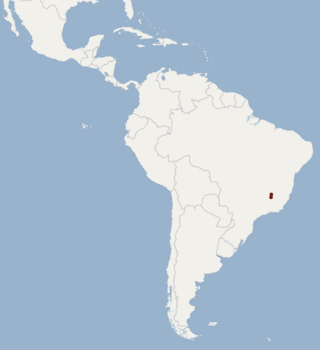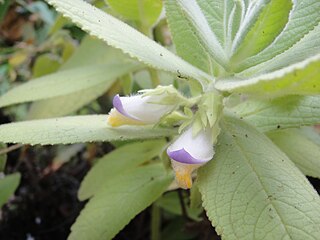
Tilapia is the common name for nearly a hundred species of cichlid fish from the coelotilapine, coptodonine, heterotilapine, oreochromine, pelmatolapiine, and tilapiine tribes, with the economically most important species placed in the Coptodonini and Oreochromini. Tilapia are mainly freshwater fish inhabiting shallow streams, ponds, rivers, and lakes, and less commonly found living in brackish water. Historically, they have been of major importance in artisanal fishing in Africa, and they are of increasing importance in aquaculture and aquaponics. Tilapia can become a problematic invasive species in new warm-water habitats such as Australia, whether deliberately or accidentally introduced, but generally not in temperate climates due to their inability to survive in cold water.

The bearded sakis, or cuxiús, are five or six species of New World monkeys, classified in the genus Chiropotes. They live in the eastern and central Amazon in South America, ranging through southern Venezuela, Guyana, Suriname, French Guiana and northern and central Brazil. The species are entirely allopatric, their distributions being separated by major rivers.

Orobanchaceae, the broomrapes, is a family of mostly parasitic plants of the order Lamiales, with about 90 genera and more than 2000 species. Many of these genera were formerly included in the family Scrophulariaceae sensu lato. With its new circumscription, Orobanchaceae forms a distinct, monophyletic family. From a phylogenetic perspective, it is defined as the largest crown clade containing Orobanche major and relatives, but neither Paulownia tomentosa nor Phryma leptostachya nor Mazus japonicus.

Dipteryx is a genus containing a number of species of large trees and possibly shrubs. It belongs to the "papilionoid" subfamily – Faboideae – of the family Fabaceae. This genus is native to South and Central America and the Caribbean. Formerly, the related genus Taralea was included in Dipteryx.

River stingrays or freshwater stingrays are Neotropical freshwater fishes of the family Potamotrygonidae in the order Myliobatiformes, one of the four orders of batoids, cartilaginous fishes related to sharks. They are found in rivers in tropical and subtropical South America. A single marine genus, Styracura, of the tropical West Atlantic and East Pacific are also part of Potamotrygonidae. They are generally brownish, greyish or black, often with a mottled, speckled or spotted pattern, have disc widths ranging from 31 to 200 centimetres (1.0–6.6 ft) and venomous tail stingers. River stingrays feed on a wide range of smaller animals and the females give birth to live young. There are more than 35 species in five genera.

Cryptanthus is a genus of flowering plants in the family Bromeliaceae, subfamily Bromelioideae. The genus name is from the Greek cryptos (hidden) and anthos (flower). The genus formerly had two recognized subgenera: the type subgenus and subgenus HoplocryptanthusMez which has been raised to the separate genus Hoplocryptanthus. All species of this genus are endemic to Brazil. The common name for any Cryptanthus is "Earth star".

Bokermann's nectar bat is a bat species from South America. It is endemic to Brazil. It feeds on nectar, and is listed as an endangered species.

Libidibia ferrea, formerly Caesalpinia ferrea, and commonly known as Brazilian ironwood, leopardtree or jucá, is a tree found in Brazil.

The Caatinga enclaves moist forests is an ecoregion of the Tropical moist forests Biome, and the South American Atlantic Forest biome. It is located in northeastern Brazil.

Linderniaceae is a family of flowering plants in the order Lamiales, which consists of about 25 genera and 265 species occurring worldwide. Vandellia micrantha is eaten in Laos, but tastes bitter. Best known are the wishbone flowers Torenia fournieri and Torenia thouarsii, which are used as bedding plants, especially in the tropics. Micranthemum is sold as an aquarium plant when it is called 'baby tears'.

Ocotea porosa, commonly called imbuia or Brazilian walnut, is a species of plant in the Lauraceae family. Its wood is very hard, and it is a major commercial timber species in Brazil.
Philcoxia is a genus of seven rare plant species in the Plantaginaceae that are endemic to Brazil and resemble terrestrial species of the genus Utricularia. The genus, formally described in 2000, consists of the species P. bahiensis, P. goiasensis, P. minensis, P. tuberosa, P. rhizomatosa, P. maranhensis and P. courensis, each of the first three named for the Brazilian state to which it is endemic. The species are characterized by subterranean stems, peltate leaves at or below the soil surface, and five-lobed calyces. Their habitat has been reported as areas of white sand in the midst of cerrado vegetation at an elevation between 800 and 1450 m. Initial descriptions of the genus included suspicions that the plethora of stalked capitate glands on the upper surfaces of leaves was an indication that these species may be carnivorous. A study published in 2007 tested P. minensis for protease activity, a typical test for the carnivorous syndrome, and could detect none. Later studies detected other digestive enzymes such as phosphatases and qualitatively assessed prey digestion and nutrient uptake, suggesting that it is a true carnivorous plant. The genus epithet honors David Philcox (1926-2003), a botanist at Kew Gardens who worked extensively in tropical Scrophulariaceae.

Syncesia is a genus of lichen-forming fungi in the family Roccellaceae.

Dipteryx alata is a large, undomesticated, edible nut-bearing tree from dryish tropical lowlands in central South America belonging to the legume family, Fabaceae, from the Dipterygeae tribe in the Faboideae subfamily. It is a wild species, widespread across the Cerrado savanna in South America. The baru nut seed is a grain legume, growing in popularity in North America as a snack food.
Philcoxia goiasensis is a rare annual herb in the family Plantaginaceae and is endemic to the Rio da Prata area of Posse, Goiás, in Brazil.

Ameroglossum pernambucense is a species of flowering plant endemic to the Borborema Plateau in Pernambuco in north-eastern Brazil. It is only found on granitic rocky outcrops in moist forest enclaves from 723 to 1,215 metres elevation. The species is threatened by drought, fires, quarrying, trampling and cattle pasturing.

Verbascum cystolithicum is a species of flowers in the family Scrophulariaceae. The species is endemic to Cape Verde. The species was first described in 1960 by Bror Johan Petterson, who placed it in the genus Celsia. Arthur Huber-Morath placed it in the Verbascum species in 1973. Its local name is mato-branco, which may also refer to two other plants.
Catimbaua is a genus of shrubs in the family Linderniaceae. It contains a single species, Catimbaua pendula. It has pendant branches, greyish leaves and red flowers. The species occurs on steep cliffs in the Catimbau National Park in Pernambuco, north-eastern Brazil. It is closely related to Ameroglossum

Isabelcristinia is a genus of shrubs in the family Linderniaceae containing a single species, Isabelcristinia aromatica. It grows on rocky outcrops called inselbergs in north-eastern Brazil in the state of Pernambuco. It has upright branches with gland-covered leaves that are aromatic to the touch. It has bilabiate flowers with a yellow lower and a pink upper lip and is likely pollinated by large bees. The genus is closely related to Ameroglossum, which is found in similar habitats, but has flowers pollinated by hummingbirds. The species is considered Endangered, because it has very little recruitment of new plants and the area where it is found is not protected and under pressure from human and feral animal disturbance.















